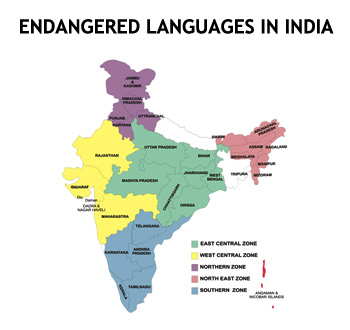Context
-
The Government of India has initiated SPPEL Scheme known as “Scheme for Protection and Preservation of Endangered Languages of India”.
About SPPEL Scheme
- The policy of the Government is to promote all Indian Languages including endangered languages.
- Under this Scheme, the Central Institute of Indian Languages (CIIL), Mysore works on protection, preservation and documentation of all the mother tongues/languages of India spoken by less than 10,000 people which are called endangered languages.
- In the first phase of the scheme, 117 endangered languages/mother tongues have been chosen from all over India for study and documentation on a priority basis.

- The University Grants Commission (UGC) has also initiated two schemes for protection of endangered languages, namely ‘Funding Support to the State Universities for Study and Research in Indigenous and Endangered languages in India’ and ‘Establishment of Centres for Endangered Languages in Central Universities’.
Back to Basics
- At the moment, the languages which are spoken by less than 10,000 speakers or languages which are not linguistically studied earlier are chiefly considered to be documented in this Government of India scheme.
- Presently, 117 languages have been listed for the documentation. Documentation in the form of grammar, dictionary and ethno-linguistic profiles of about 500 lesser known languages are estimated to be accomplished in the coming years.
Key Facts
- According to UNESCO, any language that is spoken by less than 10,000 people is potentially endangered. In India, after the 1971 census, the government decided that any language spoken by less than 10,000 people need not be included in the official list of languages.
- There are 7,000 living languages in the world and around 3,000 are considered as ‘endangered’. This means that almost half of the planet’s current linguistic diversity is under threat.
- The situation in India is alarming. Some 197 languages are in various stages of endangerment in our country, more than any other country in the world.
- India may have lost 220 languages since 1961. There were 1,100 languages since 1961, based on the Census number of 1,652 mother tongues. Another 150 languages could vanish in the next 50 years.
- There are five tribal languages that are moving towards extinction in India. Linguist experts say that the most threatened language is Majhi in Sikkim.
- According to a research conducted by People’s Linguistic Survey of India, there are just four people who currently speak Majhi and all of them belong to the same family.
- Similarly, the Mahali language in eastern India, Koro in Arunachal Pradesh, Sidi in Gujarat and Dimasa in Assam are facing extinction.
- Until recently, UNESCO has put Asur, Birhor and Korwa in its list of the world’s endangered languages with Birhor being categorised as ‘Critically Endangered’, with just 2,000 speakers left.
- While the danger of extinction looms large over some languages, many other languages have been thriving. For example, Gondi (spoken in Odisha, Chhattisgarh, Maharashtra), Bhili (Maharashtra, Rajasthan, Gujarat), Mizo (Mizoram), Garo and Khasi (Meghalaya) and Kokborok (Tripura) are showing an upward trend because educated people in these communities have started using these languages for writing.
- The extinct languages are Ahom, Andro, Rangkas, Sengmai, Tolcha — all spoken in the Himalayan belt.
Situation in Odisha
- Odisha has one of the most diverse tribal populations in India, with 62 tribes, including 13 particularly vulnerable tribal groups (PVTGs). There are 21 tribal languages and 74 dialects which immensely contribute to the linguistic diversity of the state.
- Only six tribal languages — Santali, Ho, Soura, Munda and Kui — have a written script. Santali has already been included in the Eighth Schedule.
- The state government adopted the Multi-Lingual Education (MLE) programme in 2006 to address the issues of language barriers faced by tribal children.
- In 2018, the state proposed inclusion of three major languages — Ho, Mundari and Bhumji — in the Eighth Schedule of the Constitution. There are around a million Ho speakers in Odisha, 0.6 million Mundari speakers and 0.3 million Bhumij speakers.
Way forward
- Tribal languages should be endorsed through innovative, cultural and entertainment programmes, suggest linguistic experts.
- For example, in February this year, a local community radio channel called ‘Asur Mobile Radio’ in Jharkhand launched cultural programmes in the Asur language, which has only 7,000-8,000 speakers.
- The Asur community is among the few PVTGs in the state to preserve their language.
- The Asur language features in the UNESCO list of ‘definitely endangered’ languages.
- Local civil society organisations and cultural institutions should make dramas and films in native tribal languages. This will ensure a wider outreach and encourage the younger lot to preserve and respect their language.
- There is a need to promote tribal languages as a medium of communication and education in tribal-dominated districts. It can significantly reduce the communication gap and school dropout rate.
- It is important to integrate indigenous knowledge systems alongside modern sciences in the curriculum of schools. Tribal languages are fundamental to understand the world we live in, our origin, the roots that we all came from and what humans are capable of.
Conclusion
- Therefore, it is high time for others to appreciate the important contribution of tribal languages in enriching the world’s rich cultural and linguistic diversity.
Visit Abhiyan PEDIA (One of the Most Followed / Recommended) for UPSC Revisions: Click Here
IAS Abhiyan is now on Telegram: Click on the Below link to Join our Channels to stay Updated
IAS Abhiyan Official: Click Here to Join
For UPSC Mains Value Edition (Facts, Quotes, Best Practices, Case Studies): Click Here to Join
